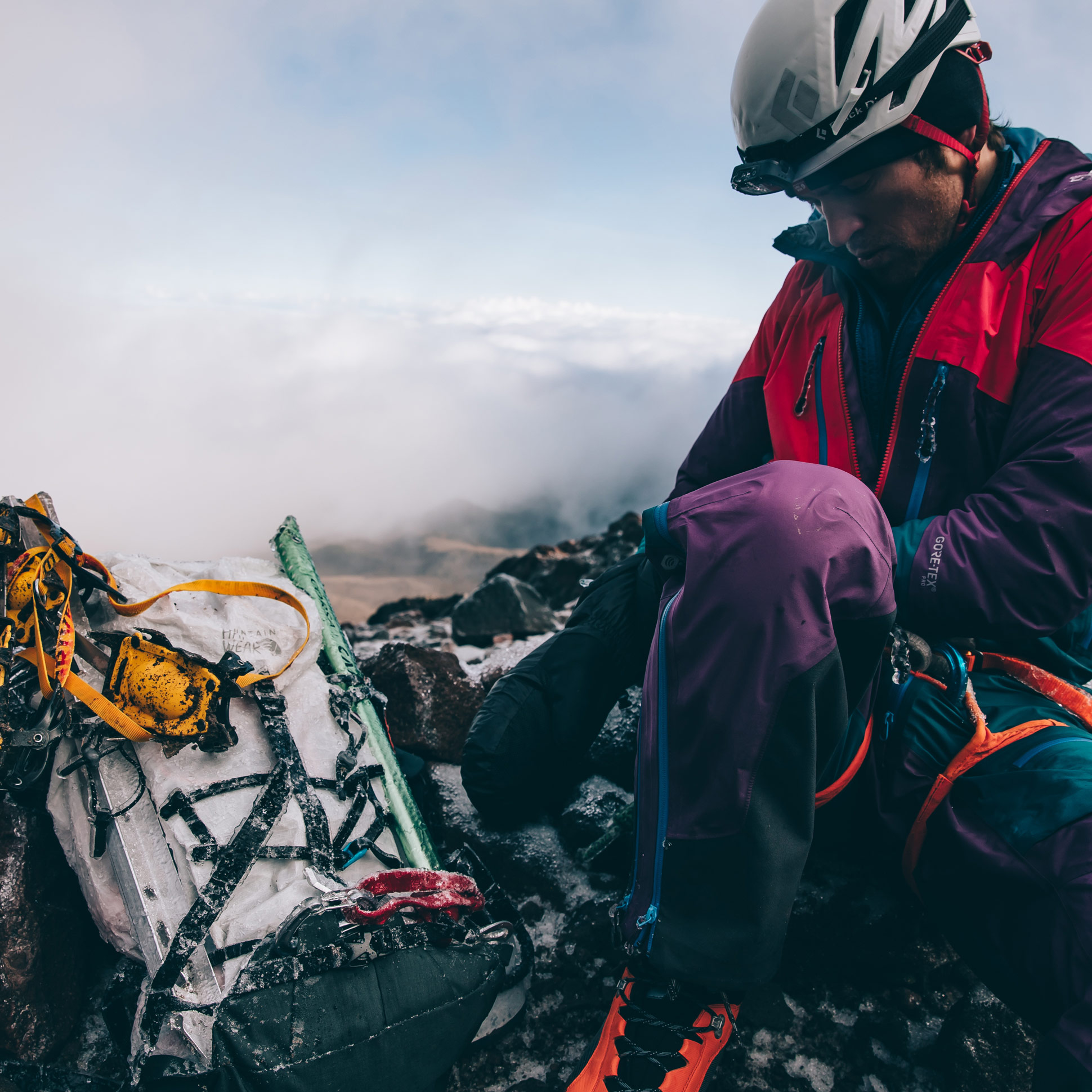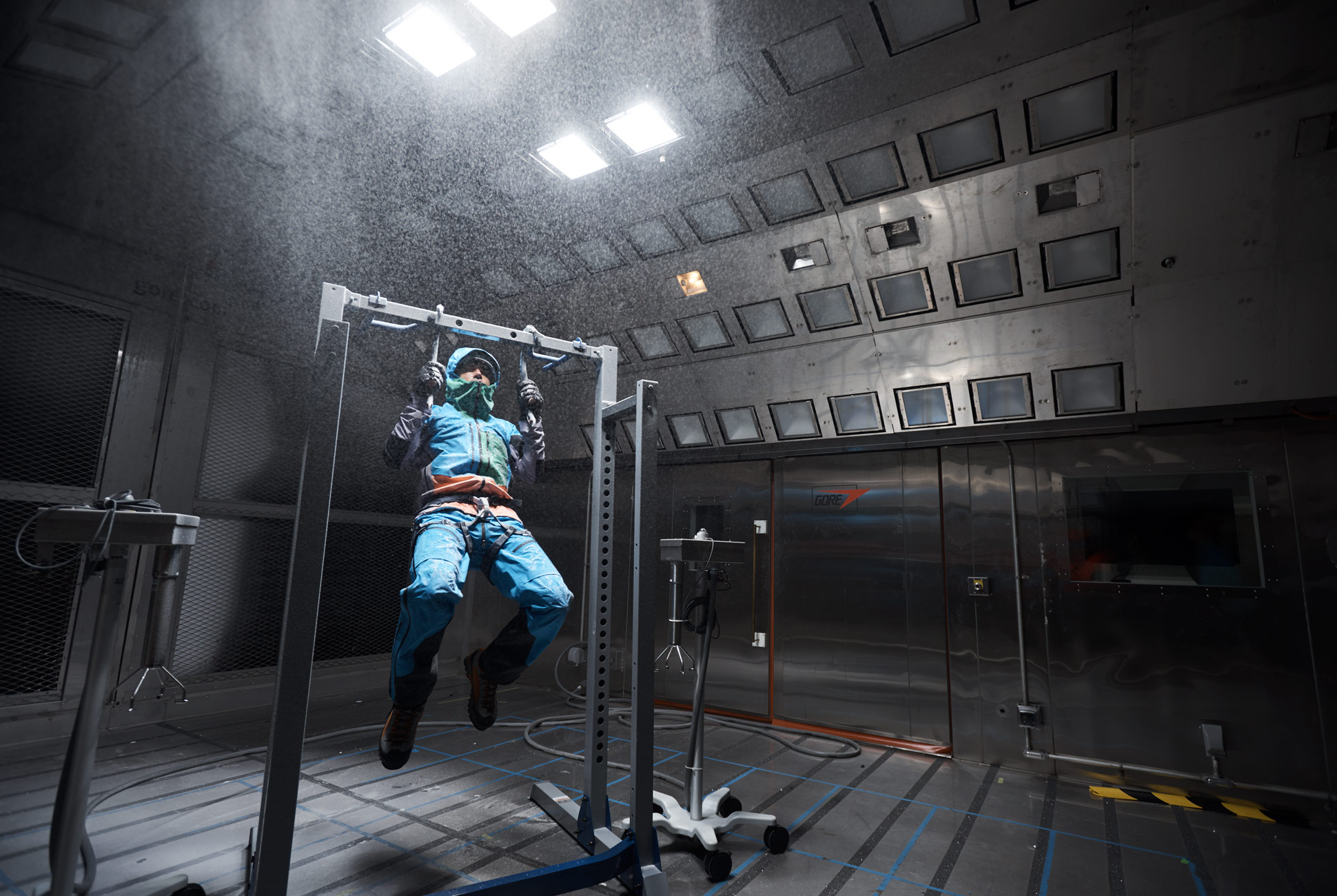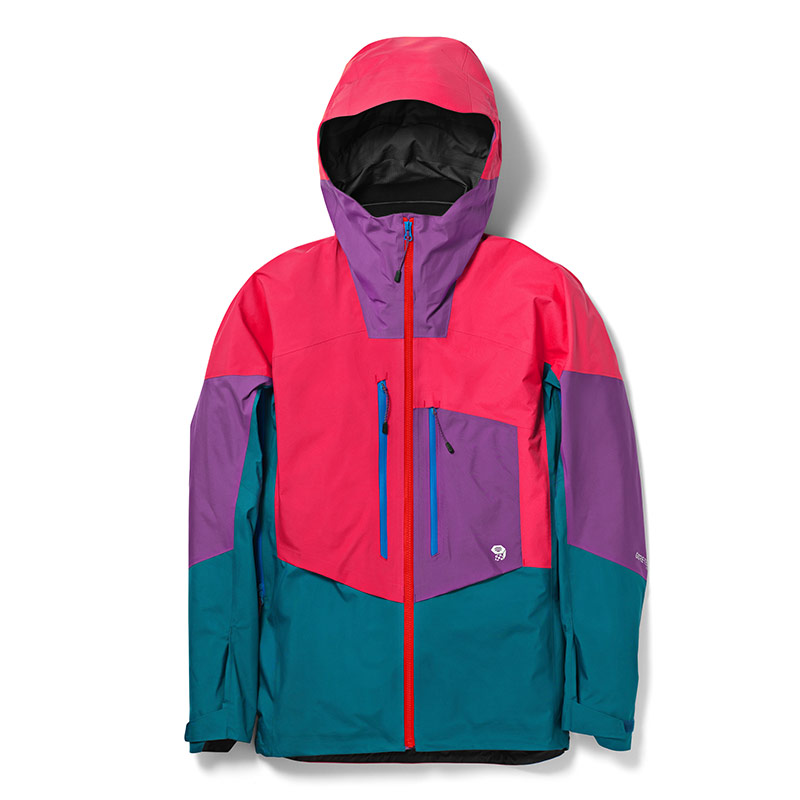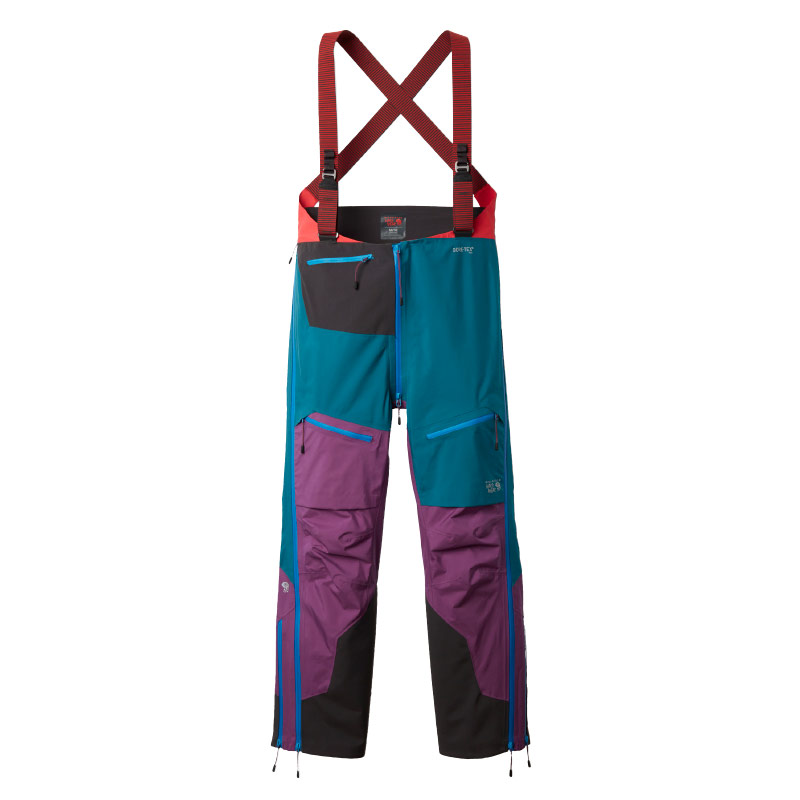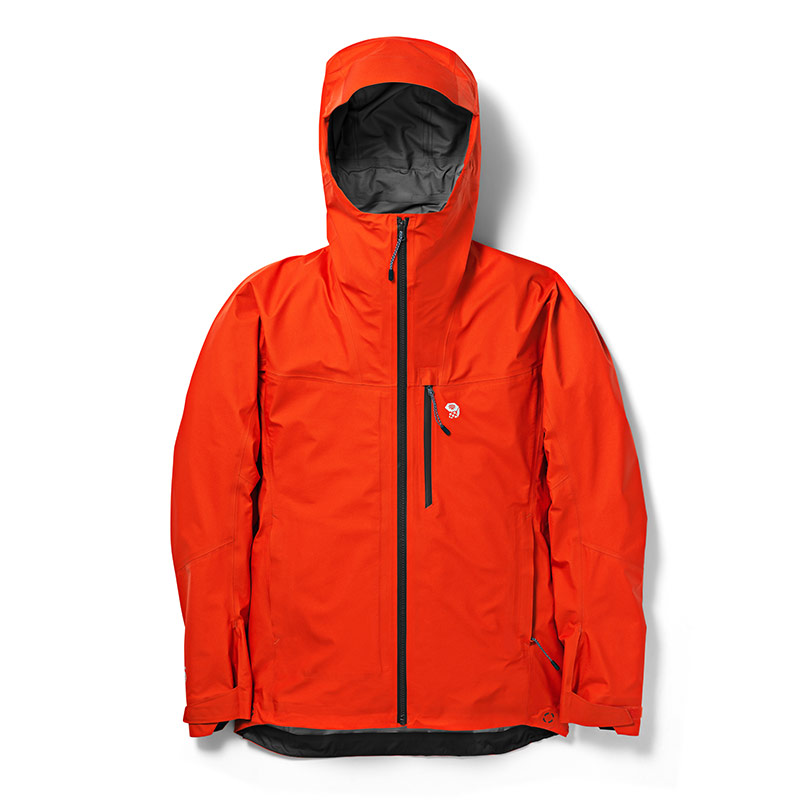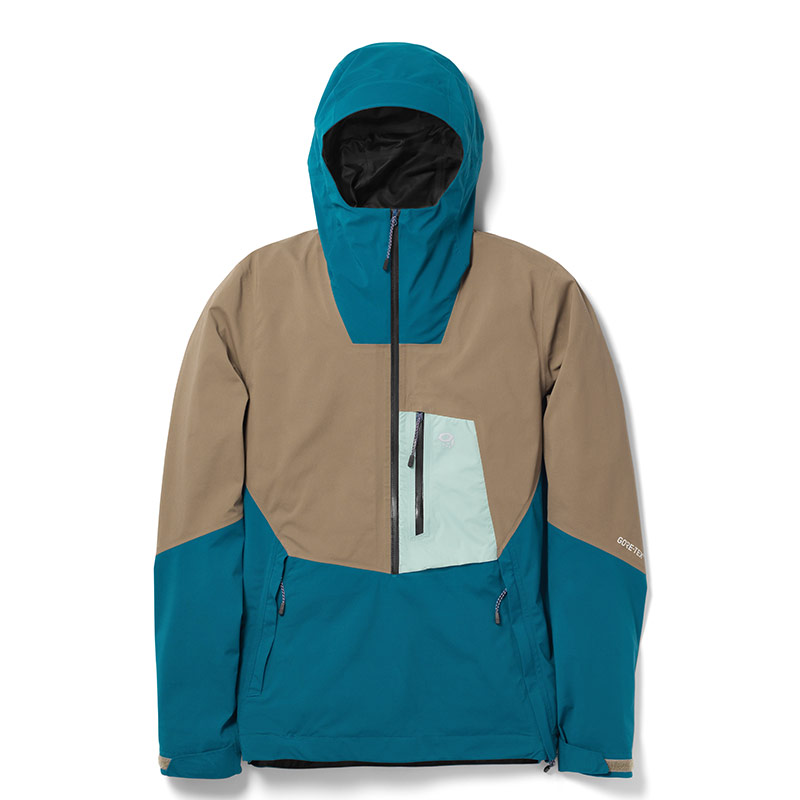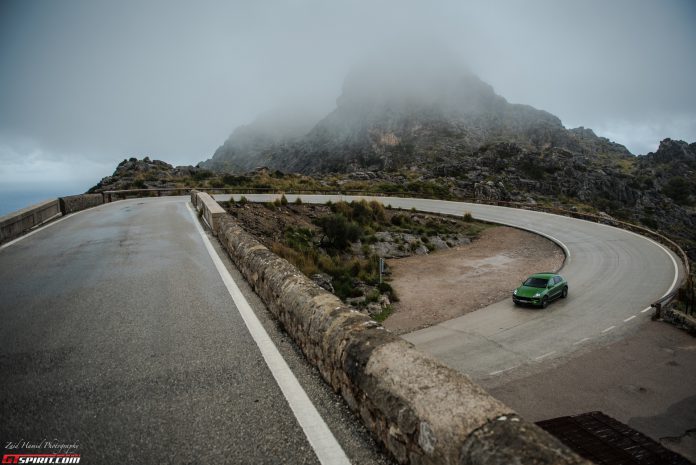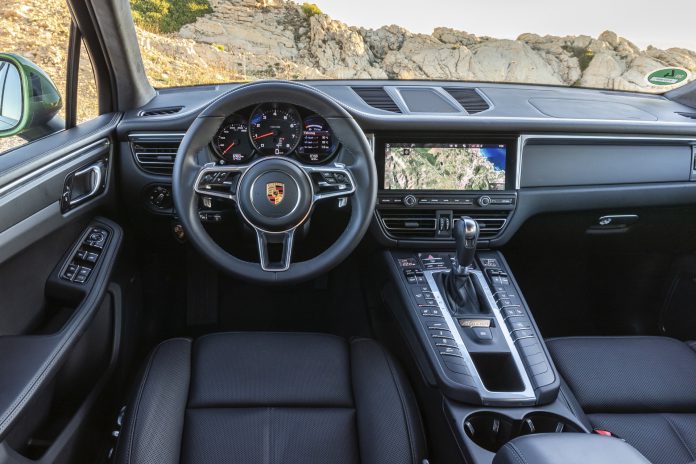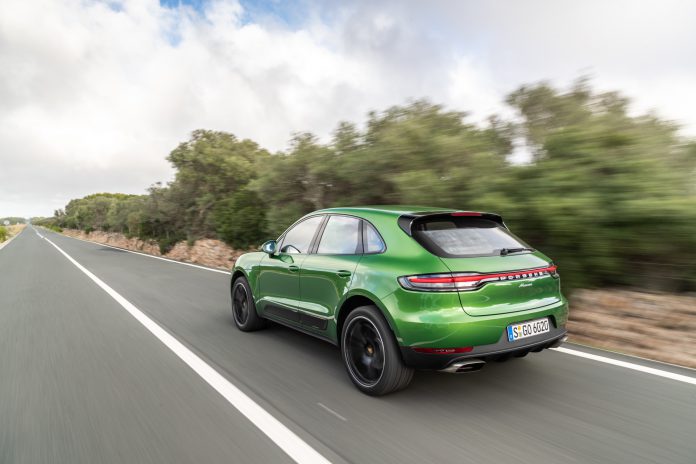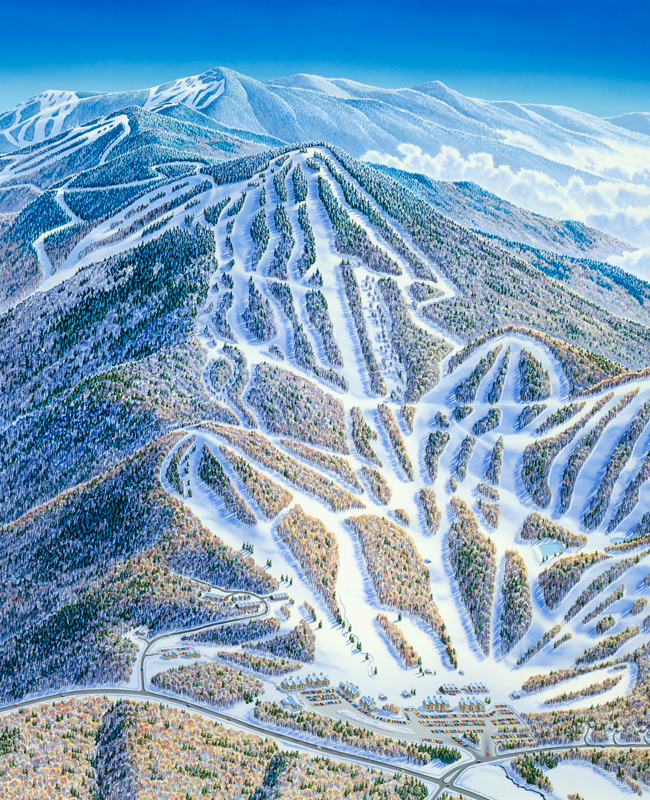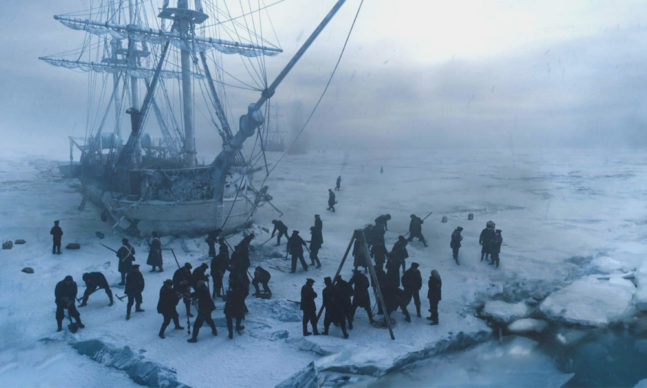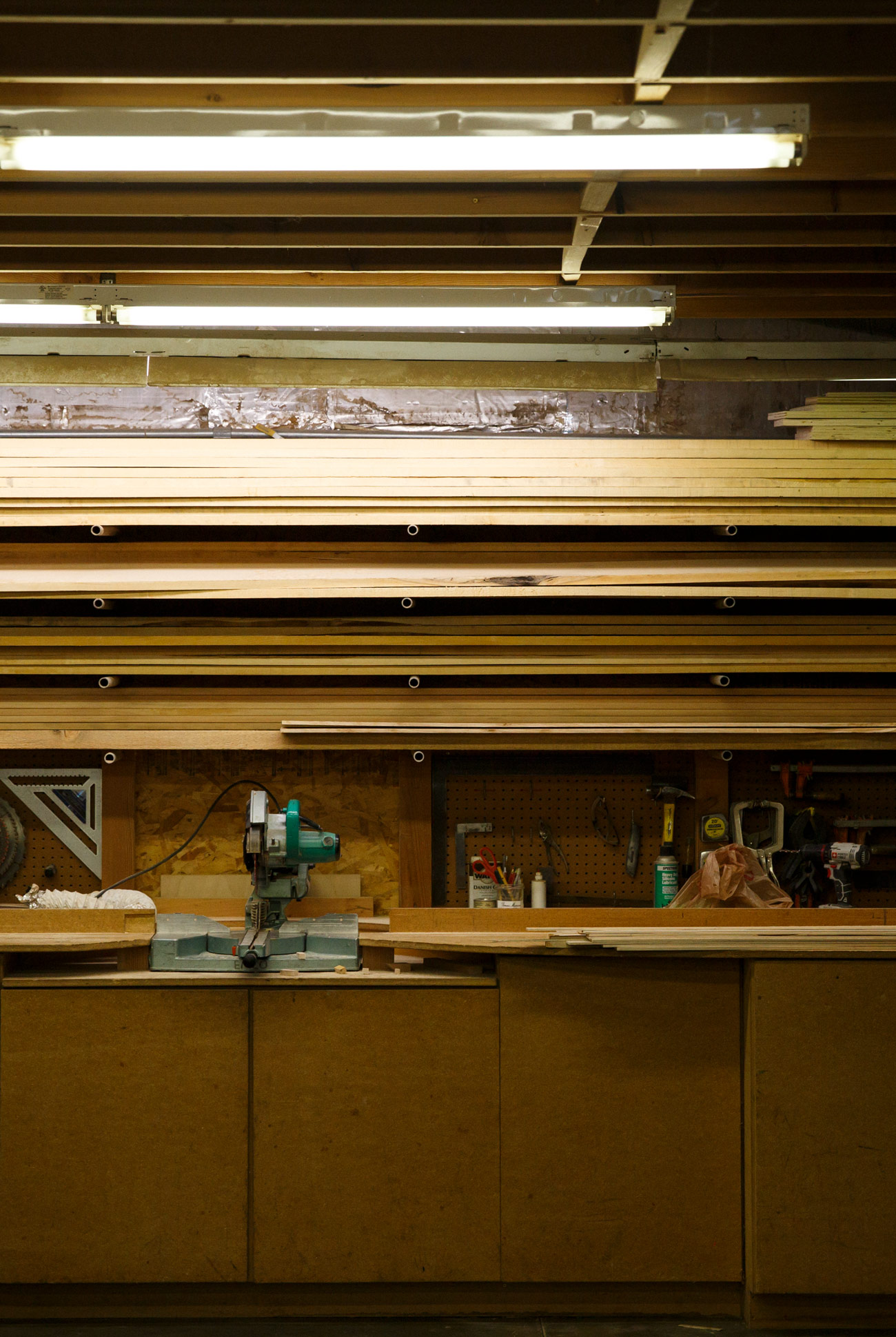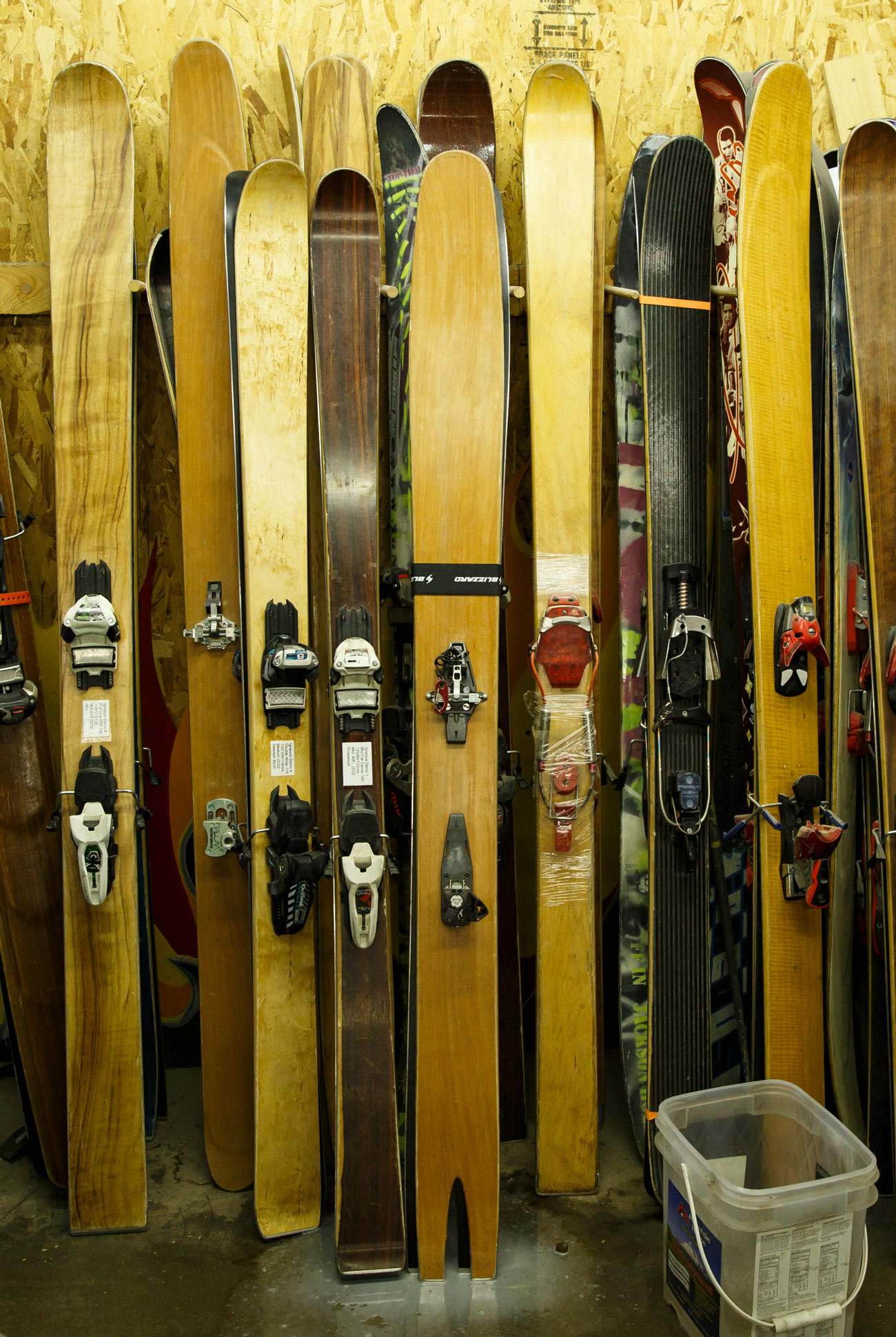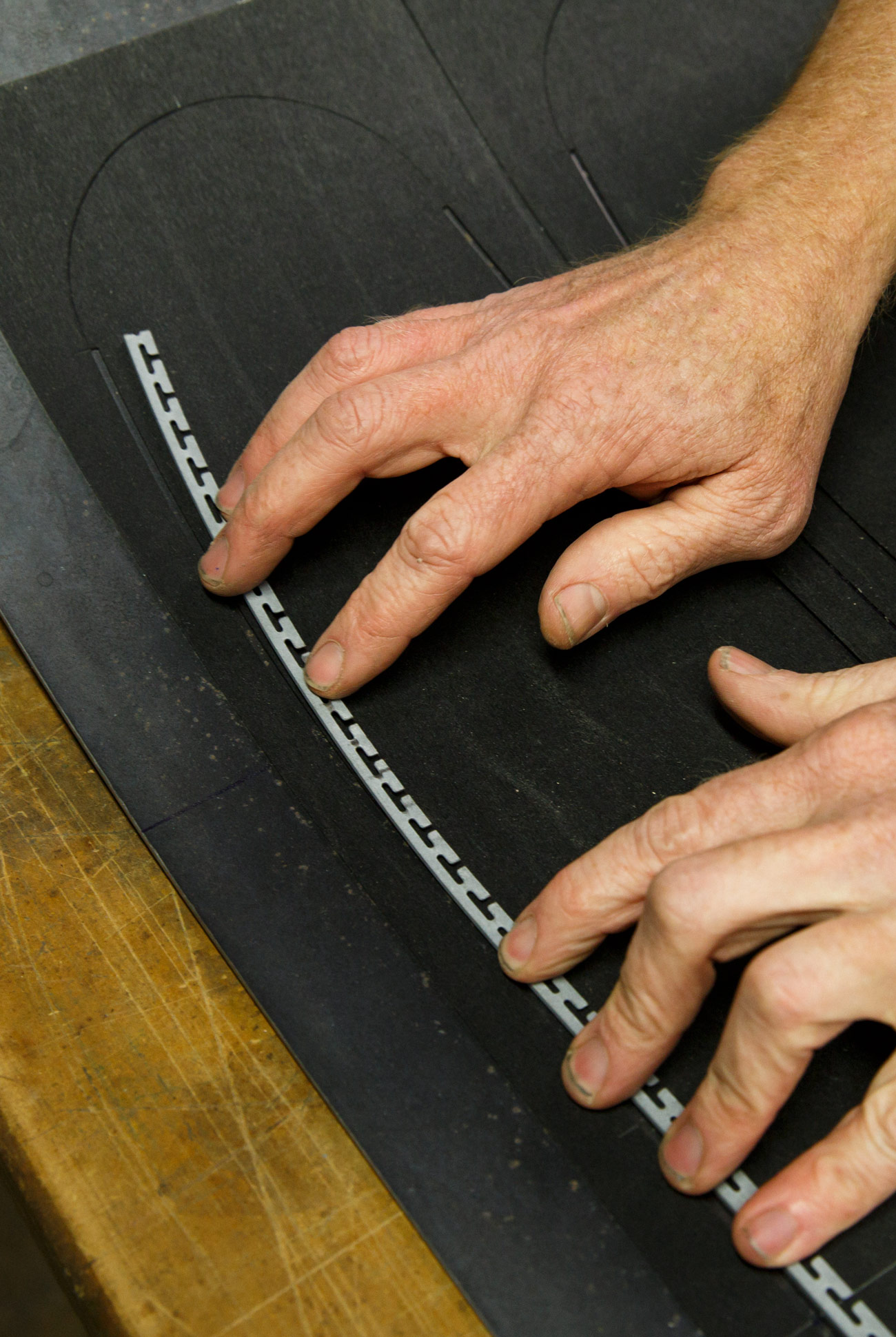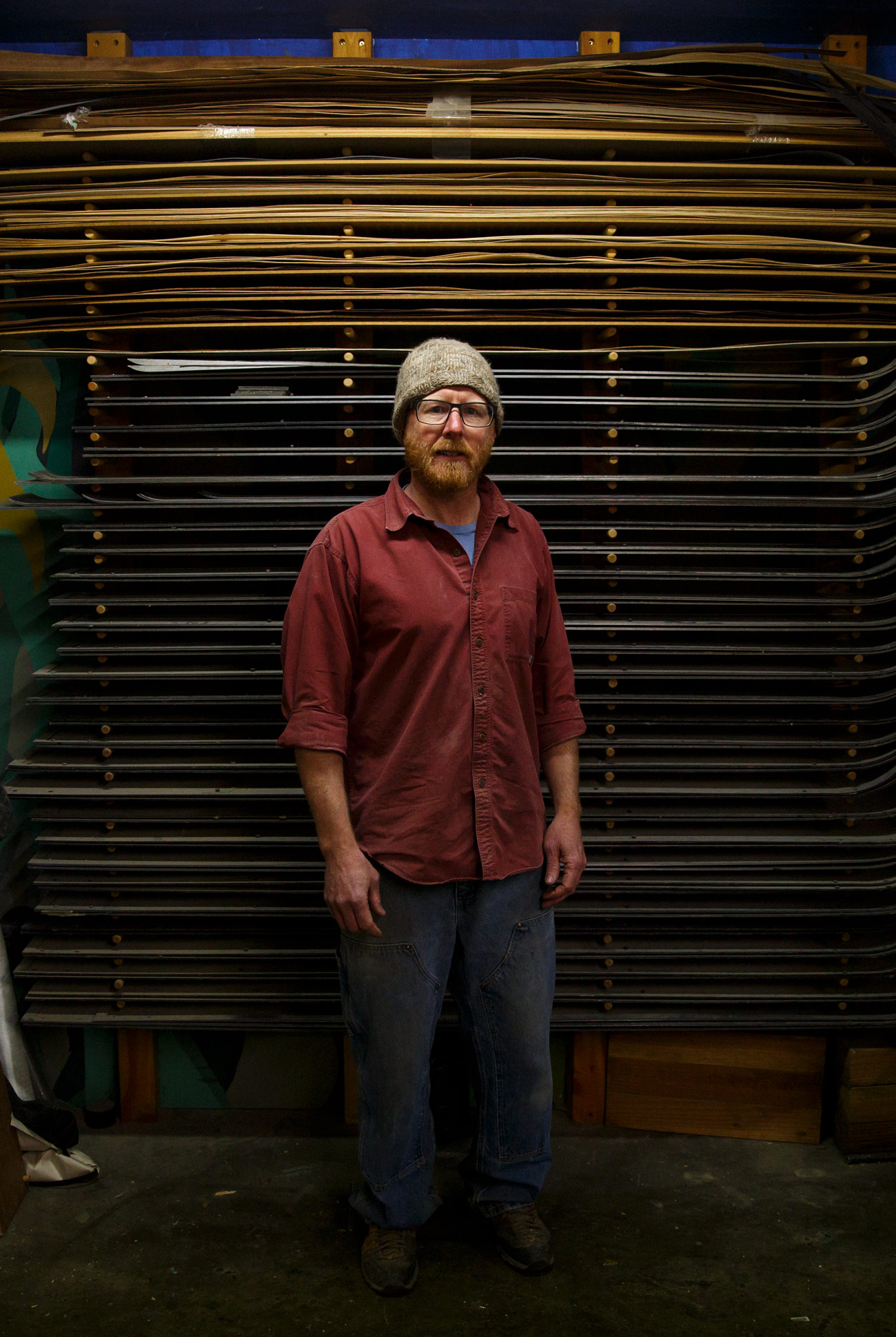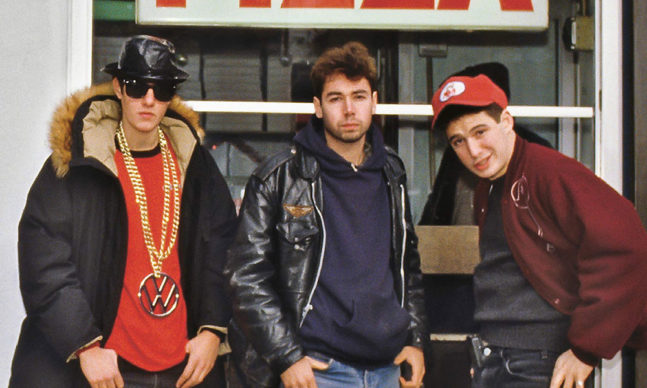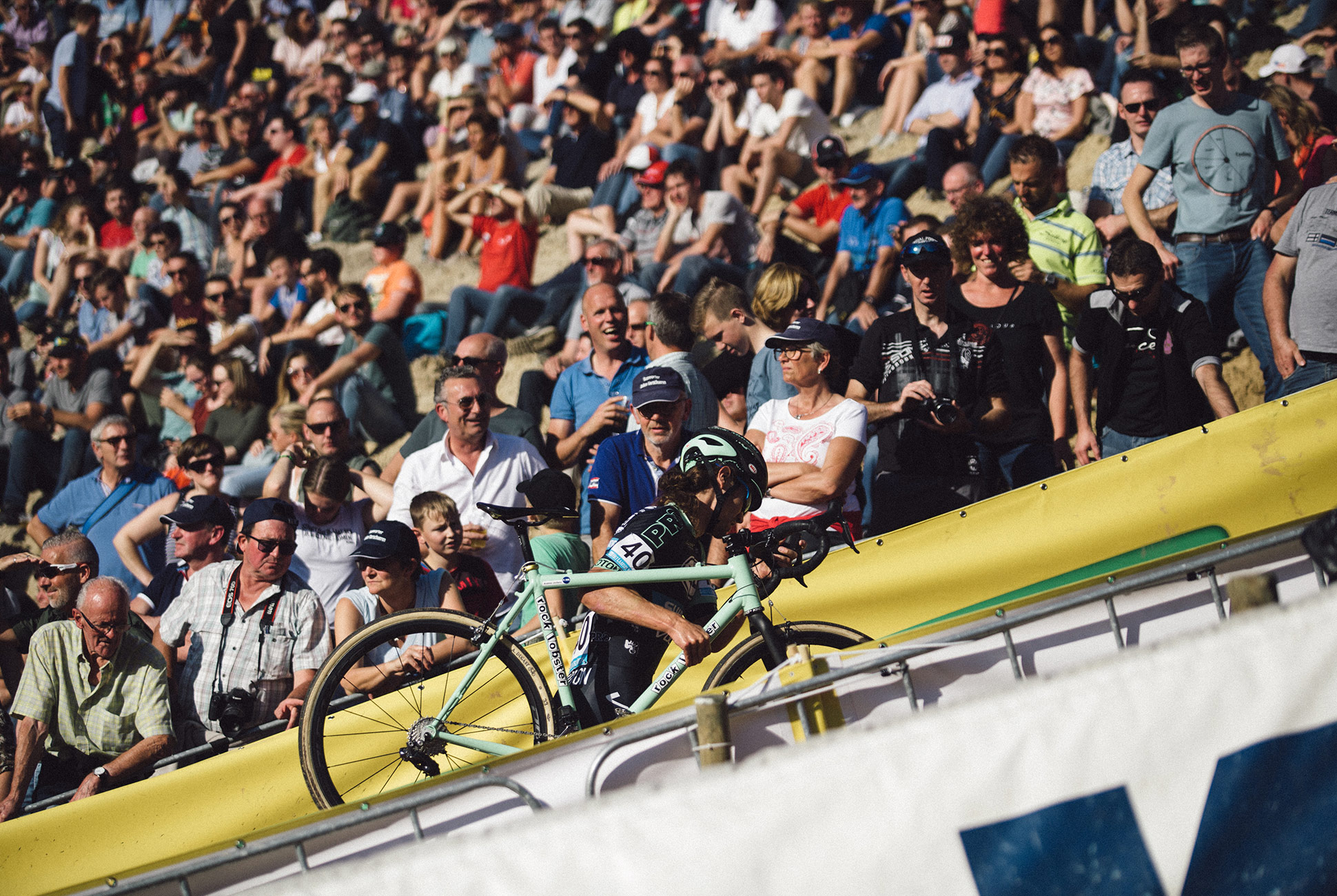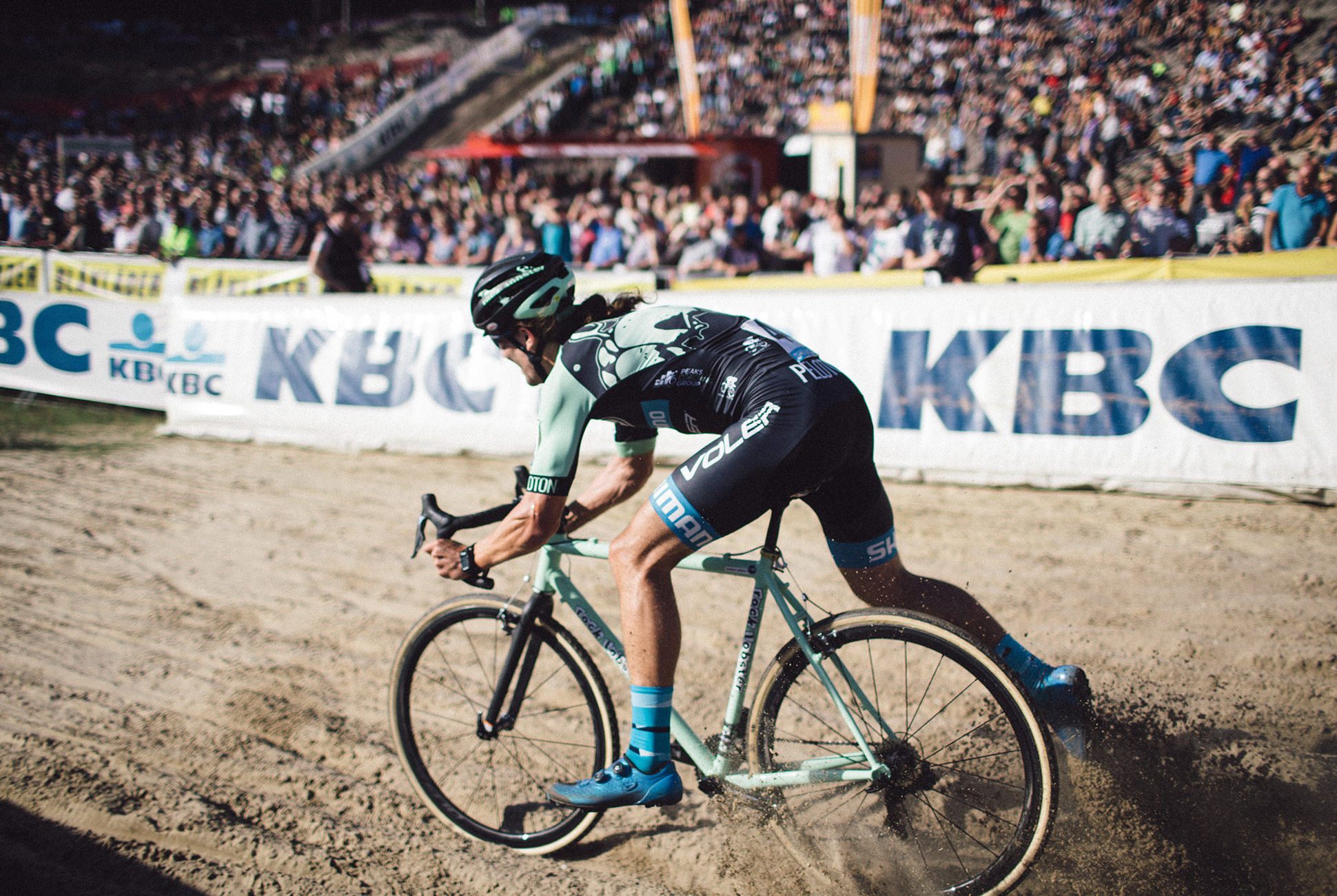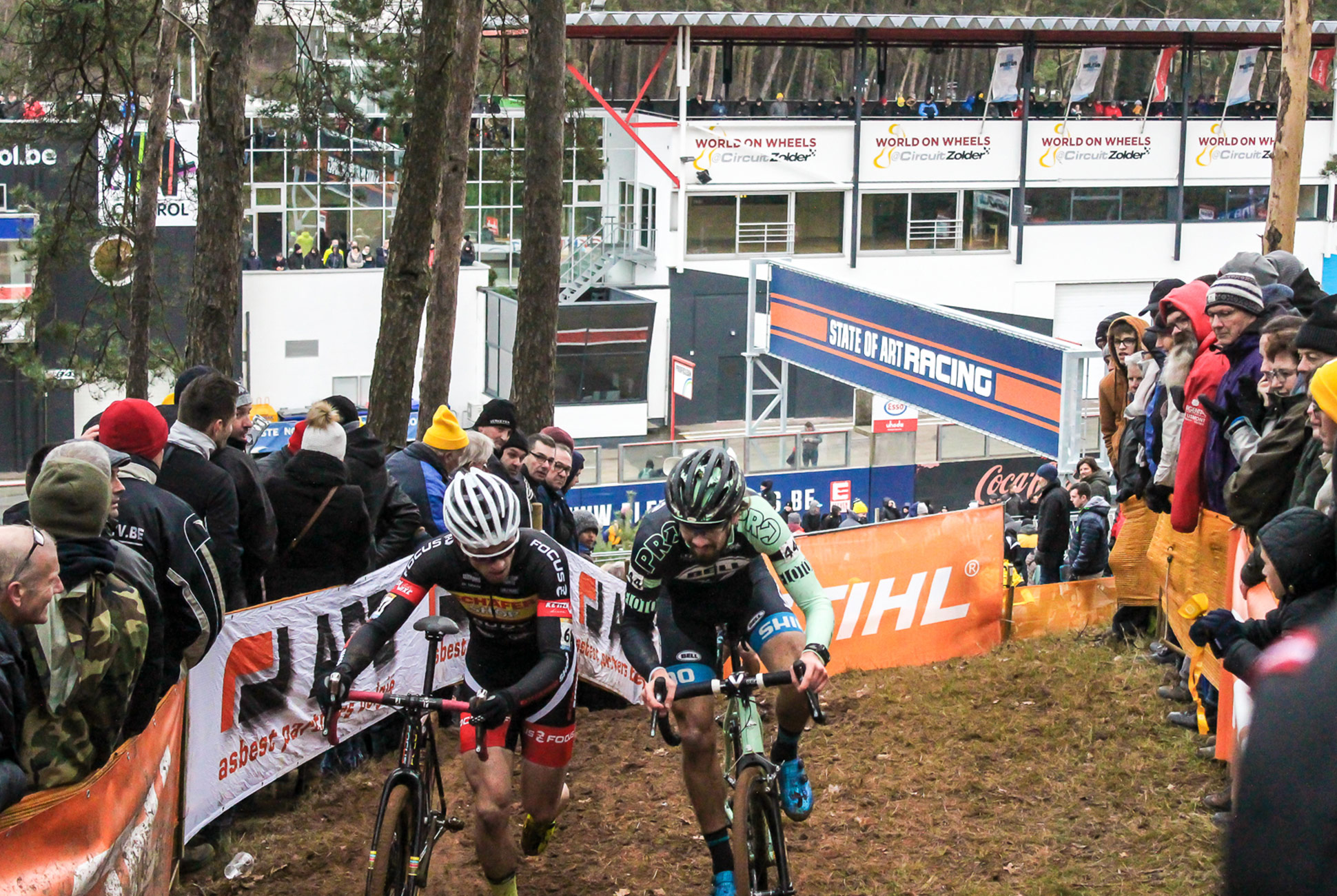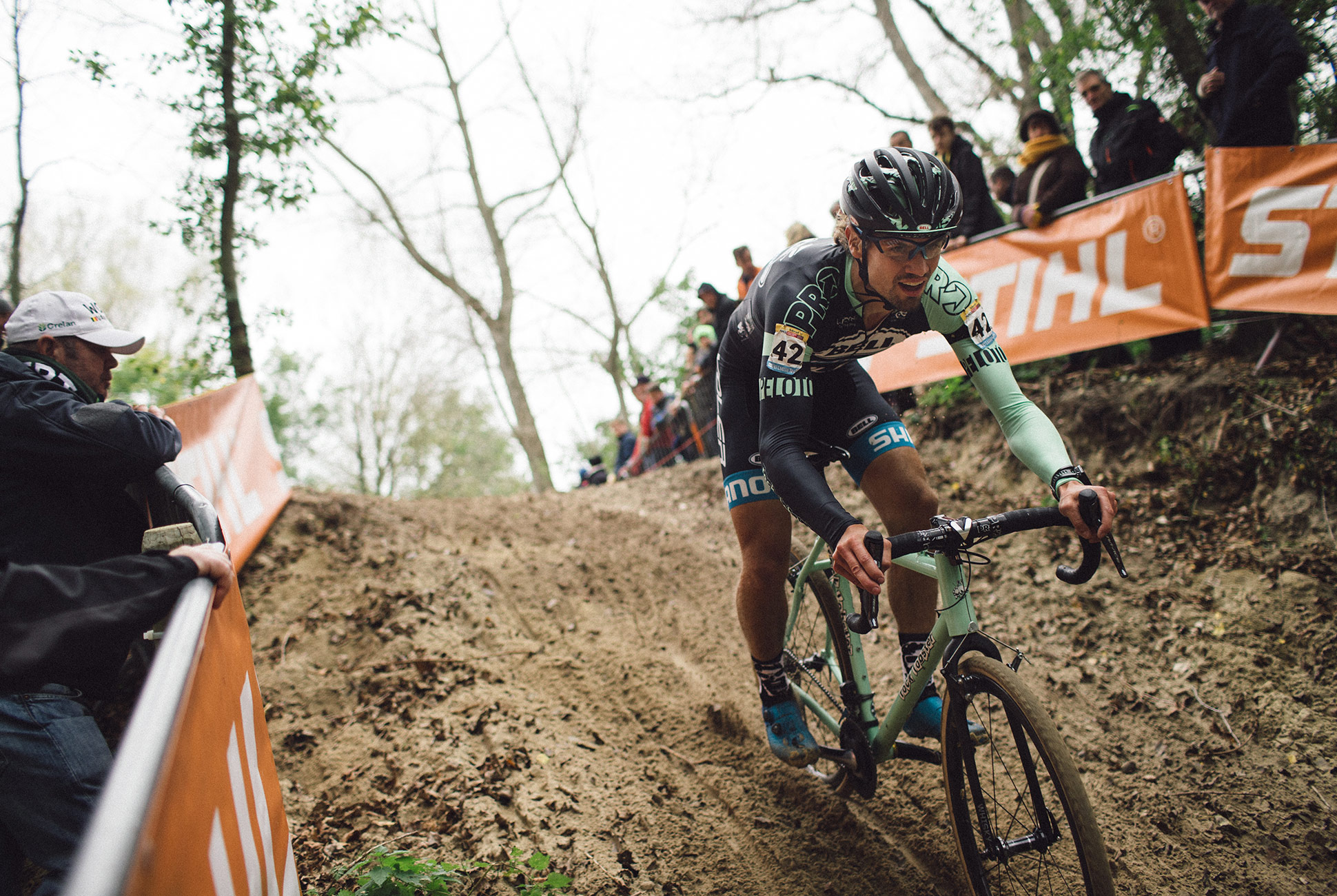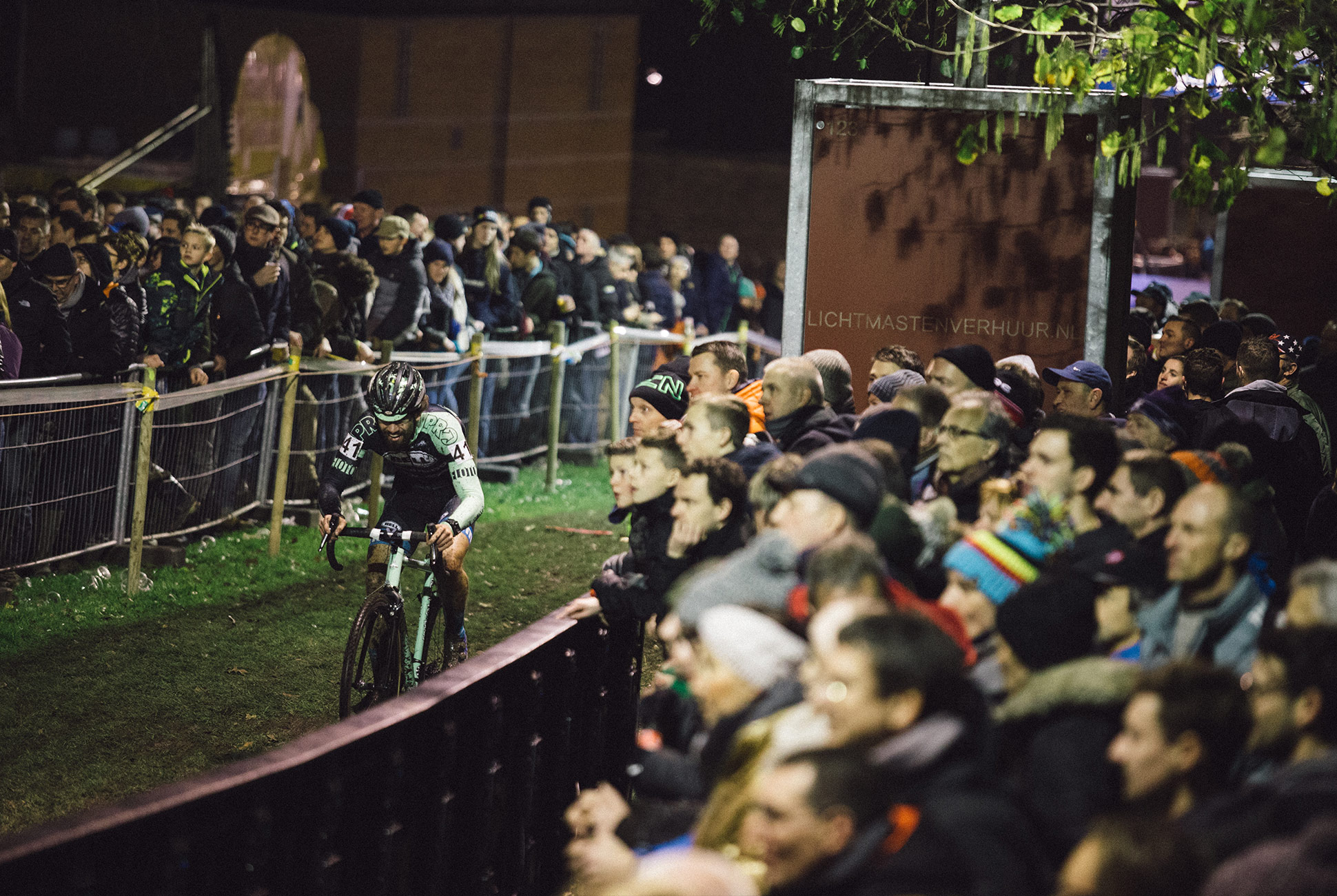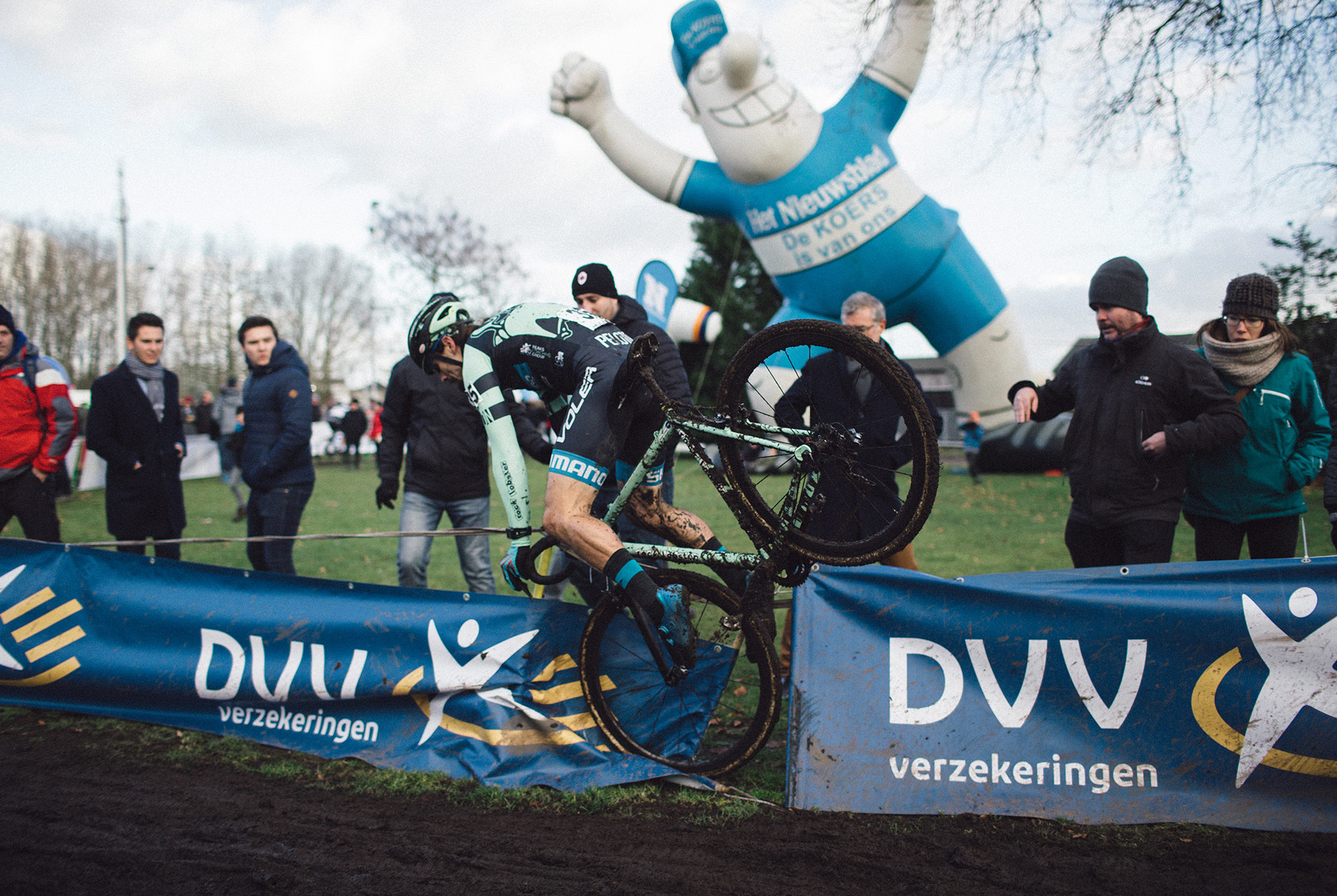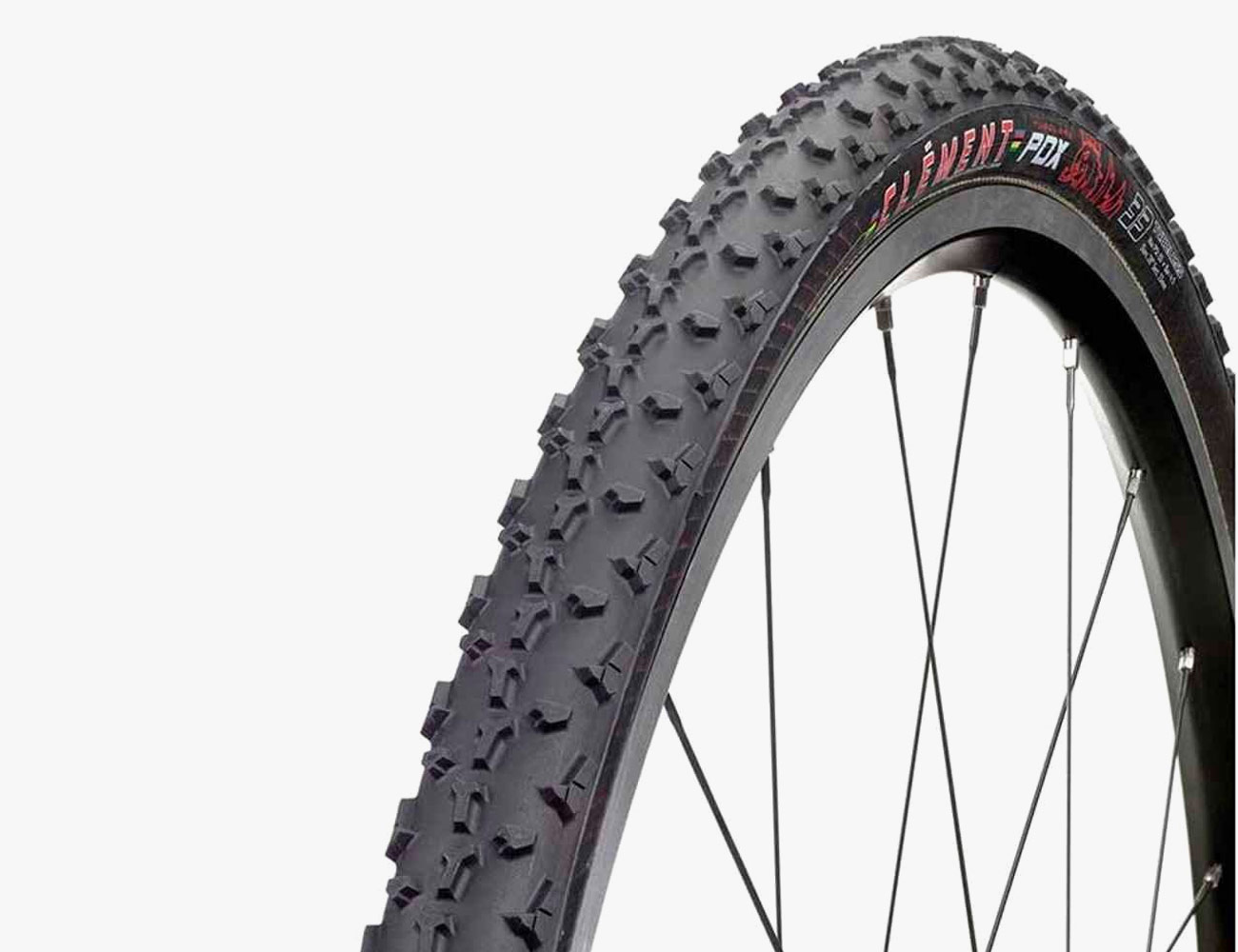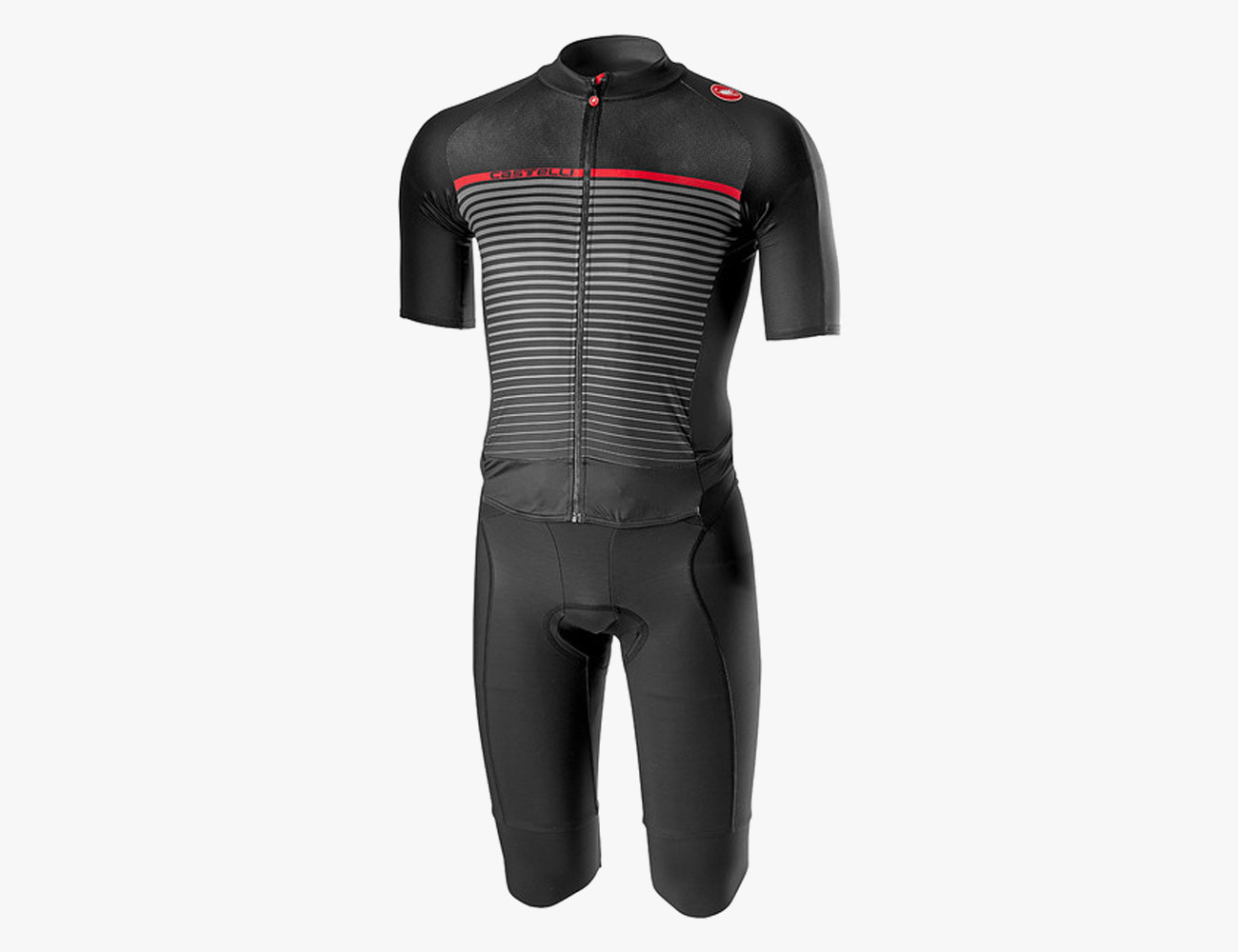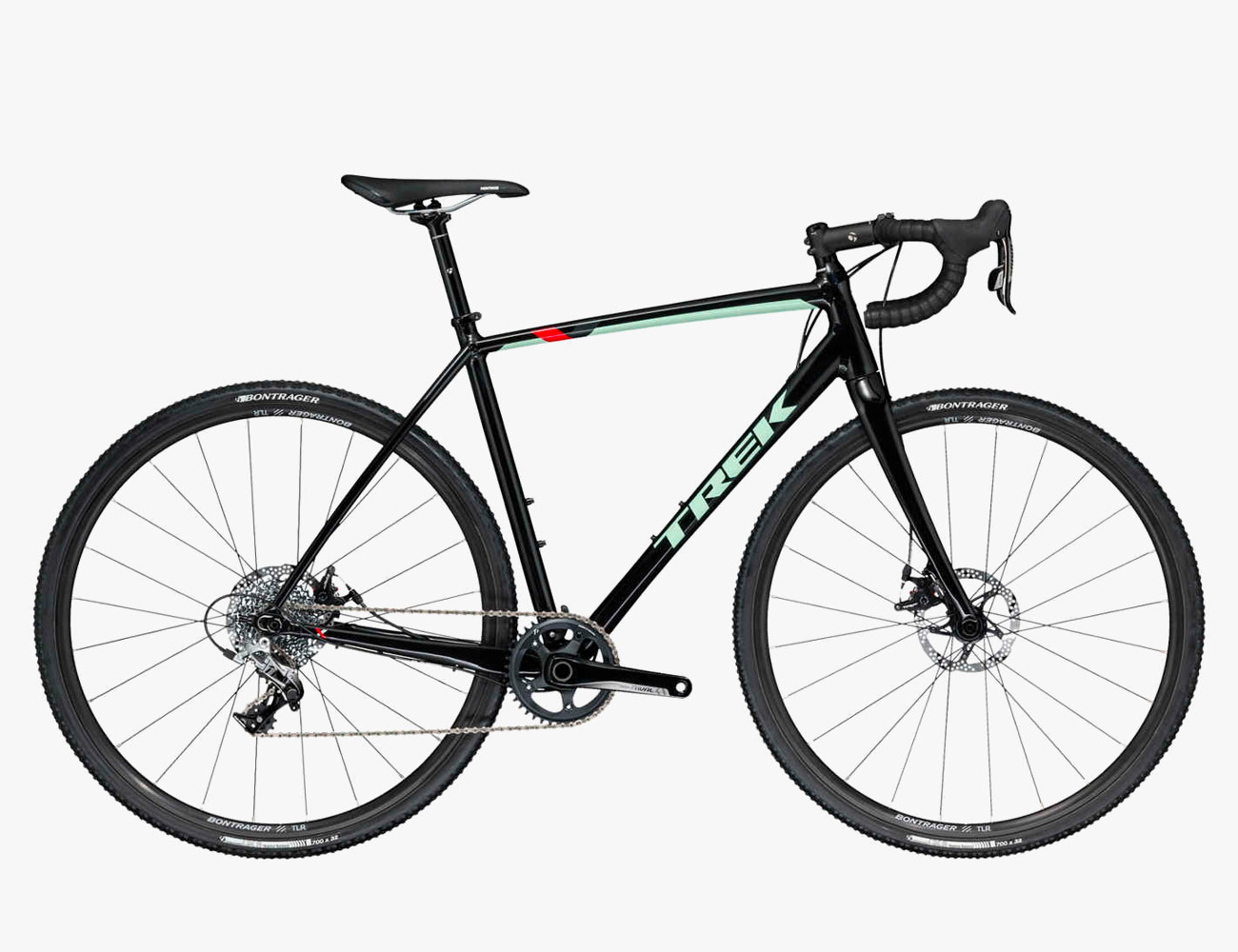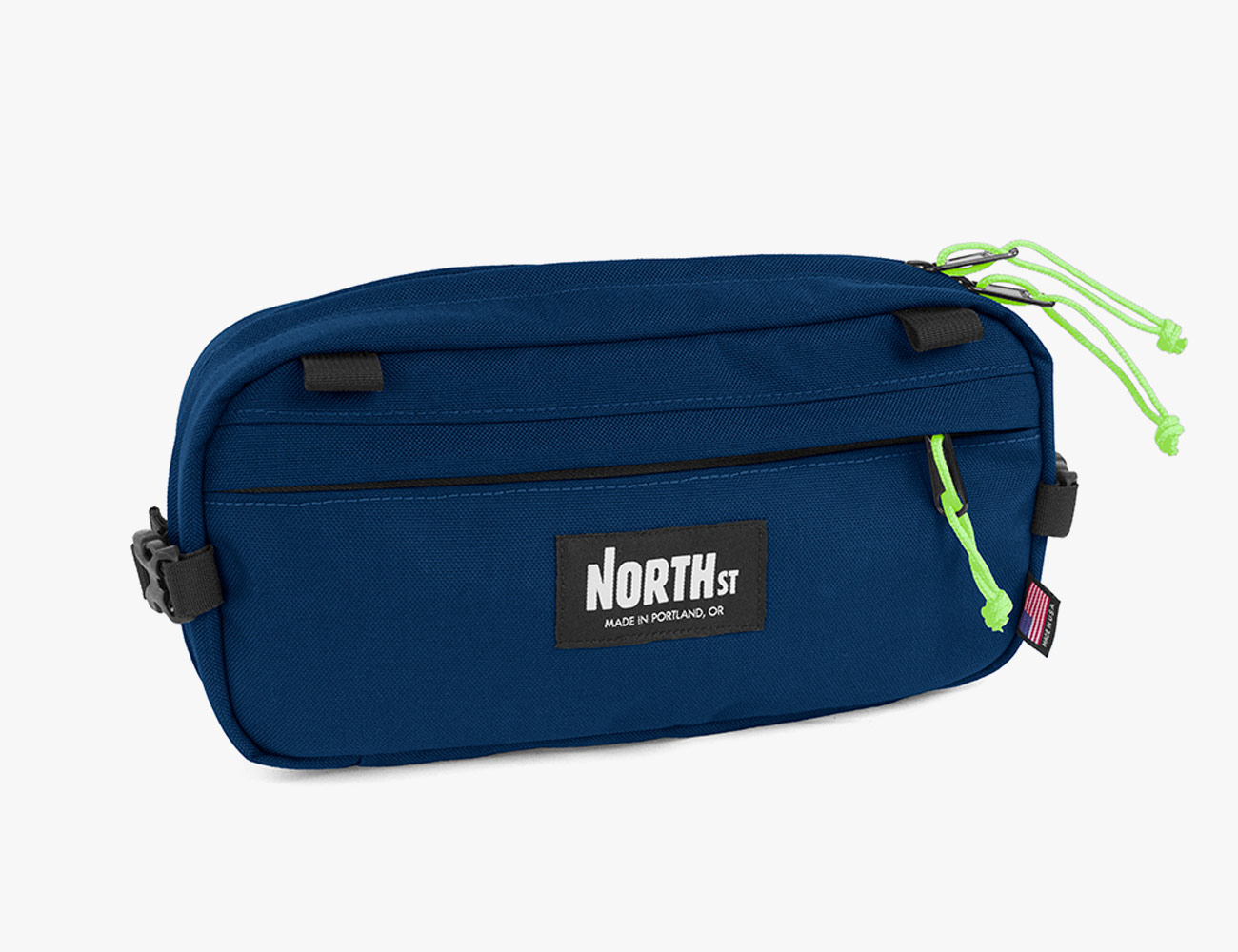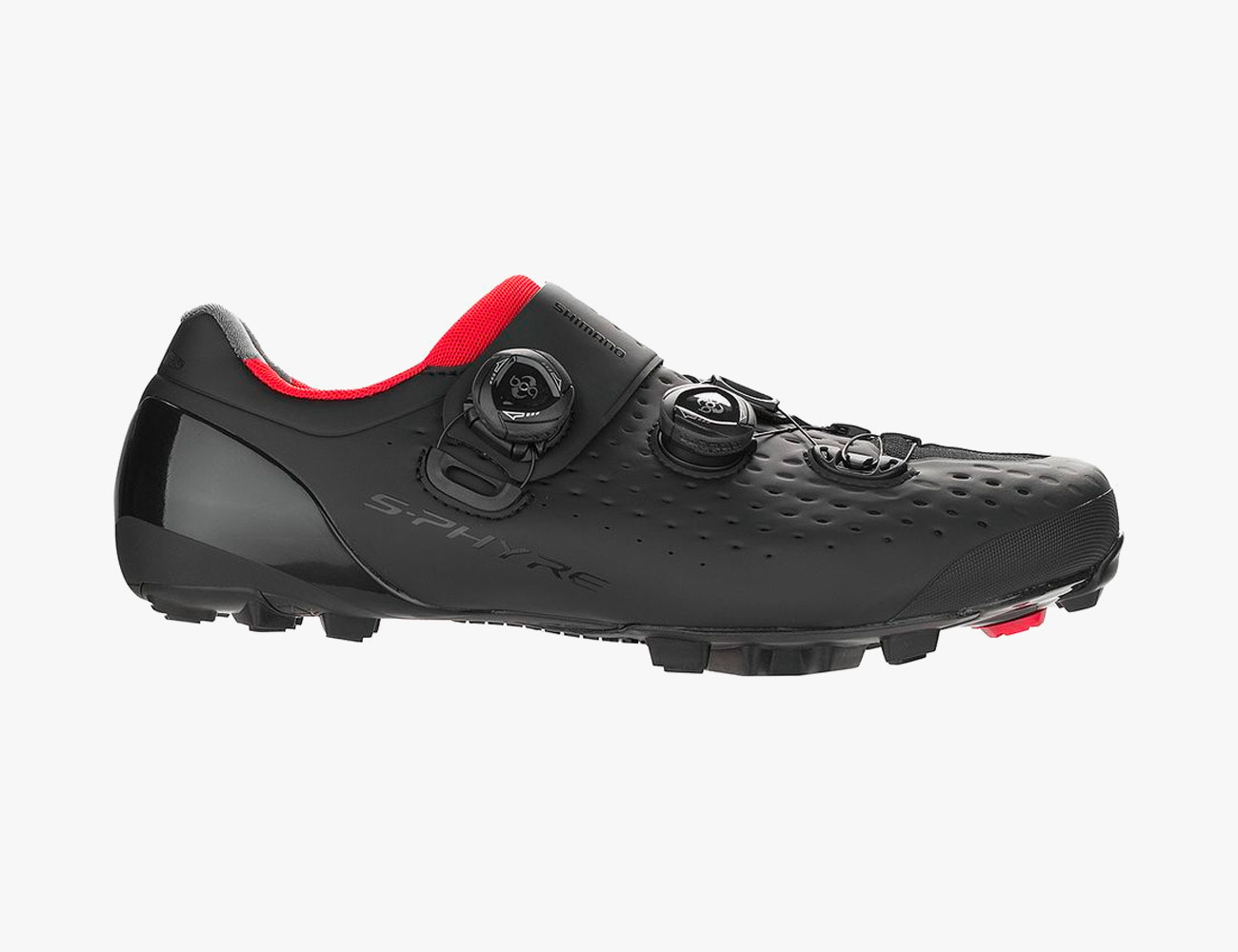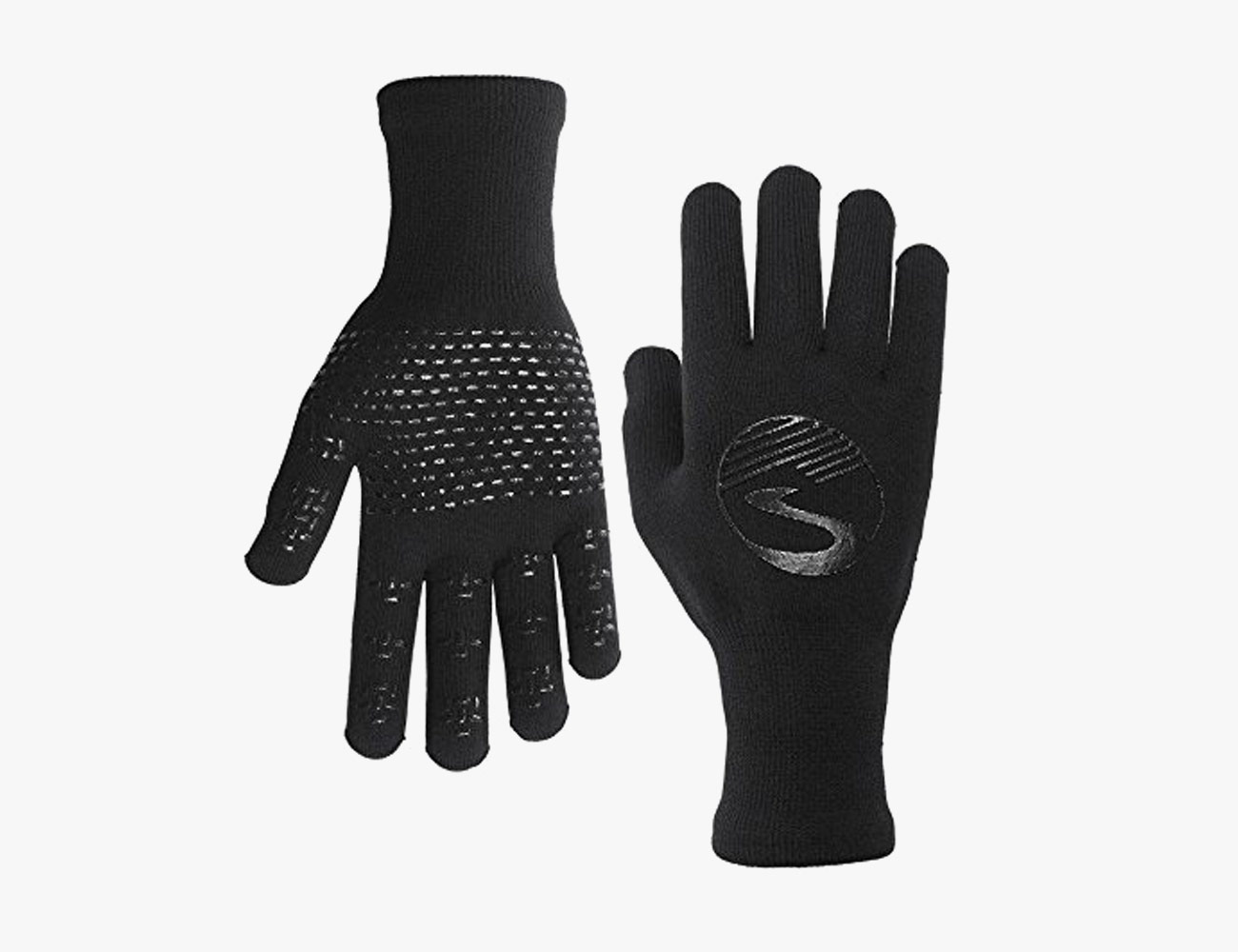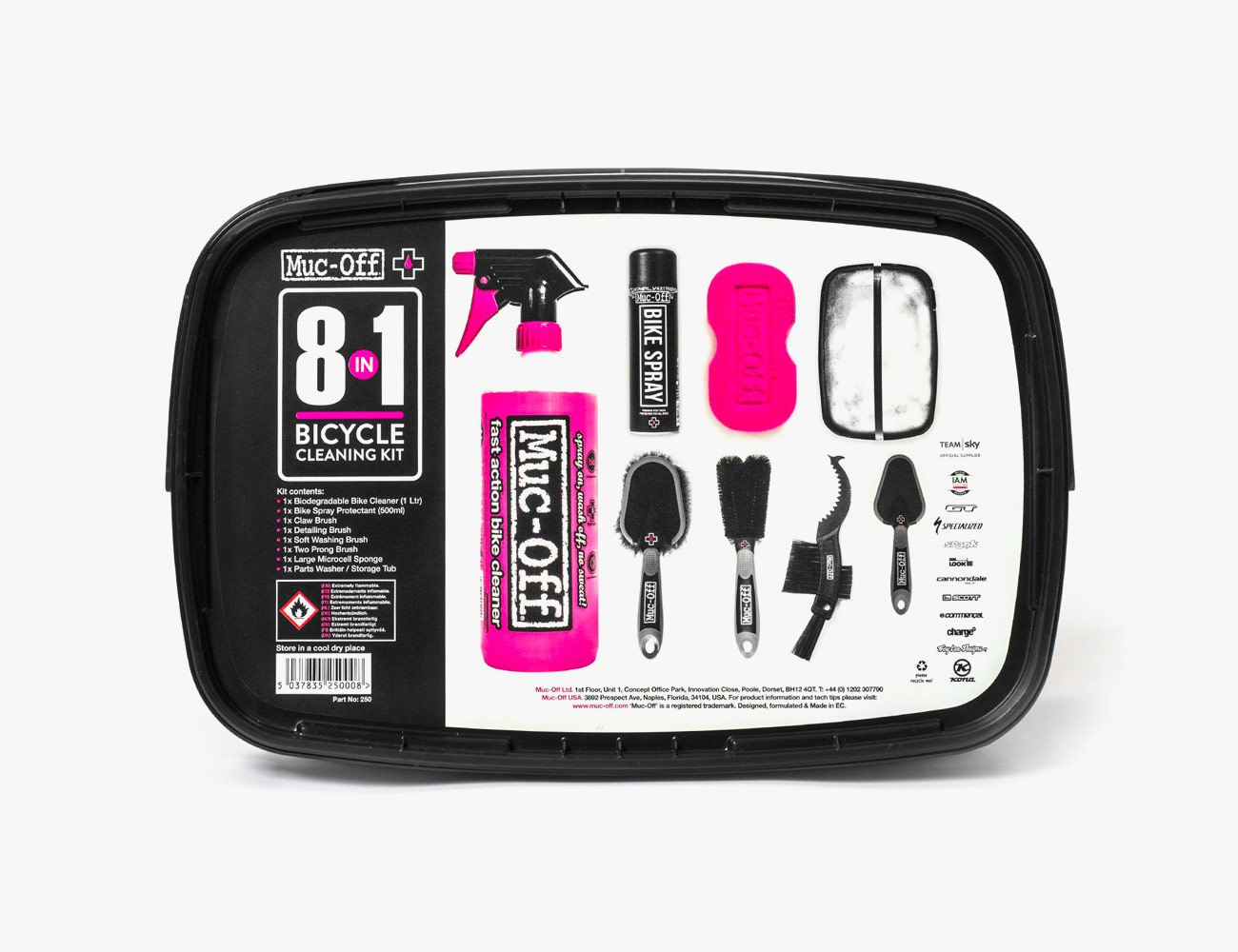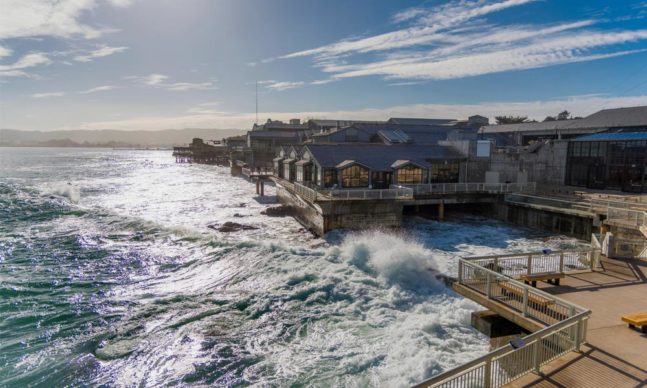Photos by Stuart Palley.
Depending on conditions and their orders, firefighters build their line anywhere between miles and a stone’s throw away from the flames. Out front are the sawyers, who use chainsaws to cut trees and heavy brush, and swampers, who assist them and haul away the firewood. Behind them, the rest of the crew use hoe-like tools called pulaskis and shovels to cut into the earth, robbing the fire of its fuels and feeding it only dirt. When burning embers jump the line, starting spot fires on the line’s far side, crews sprint to its nascency and beat it out with their tools and their piss pumps. Occasionally, they light their own fires to clear out areas in front of a fire, robbing it of its fuel proactively.
Heat can be unbearable when the fire-line digging runs up against the flames. Boot soles delaminate and disintegrate if firefighters have the misfortune to linger on a ground hotspot. Flaming trees pop and explode. Shifting winds rain embers and ash on the men. Strict rules keep them from removing their heavy packs from their backs as they work.
Little has changed about this fire-line process in over 100 years. The pulaski hand tool, on one side an ax and the other an adze, has borne a “Super P,” an enlarged version of the former. Crews have also innovated “combi,” or combination, tools. Chainsaws have increased in power and decreased in size. “But other than that, digging line, clearing brush and digging, it is just the same hard, physical labor,” said Steve Gage, an assistant director of Fire & Aviation Management for the US Forest Service who’s been fighting fires since the 1970s.
There are approximately 14,500 federal wildland firefighters in the US today, down from approximately 16,000 four years ago, according to testimony by USFS Chief Thomas Tidwell before the Senate Committee on Energy and Natural Resources. This summer’s intense season has revealed that this is too few, even with state and local firefighters, volunteers, international fire crews and even the military pitching in. “We are basically stretched really thin,” said Gage. “In years past, we used to stand up 600 to 800 hand crews to commit to fires.” But because of changes in demographics and economics, Gage said those numbers are down. And they can’t be spun back up in time to respond to a particularly bad fire season. “Folks need to understand,” he said, “when we get into a fire situation, we can’t just go down to the temp service. It takes training and physical ability for people to go out and fight fire.”
For the firefighters on the ground, this shortage of manpower means shifts that are supposed to last 12 hours are stretching to 14, 16, 24 or even 36 hours. They work a two-one shift — one hour of rest for every two hours worked. After their hours on the fire line, they sleep at a fire camp, usually made up of personal tents or, sometimes, a school gymnasium. Hot food is prepared to keep them fed. Every few days they get a shower. Weaver said many teams are getting only two days off between two-week assignments, sometimes less.

Photo by Stuart Palley.
Firefighters have a safety saying: “Keep one foot in the black.” They’re referring to staying on the edge of an area that’s already been burned over and is a safe refuge from flames. But there’s also the unspoken half of the saying: they always have one foot in the fire, too.
“Anybody that does the job enough will have close calls,” said David Zortman, a crew chief for the Tatanka Hotshots, an elite wildland firefighting crew based out of Custer, South Dakota. Zortman’s came while fighting a fire outside of Los Angeles, when a huge boulder, loosened by fire, pinballed down a draw straight toward him. He crawled just out of its way. Steve Gage said he once had to hunker down among rocks while a fire burned directly over him. Weaver was fighting a fire on military property when her commander picked up a piece of unexploded ordinance and said, “Whoa, look at this!” Tripp of the Yellowstone fuels crew was “smoked out” and forced to retreat through a boulder field when the wind on a fire he was scouting alone shifted 180 degrees. Another Yellowstone fuels crew member suffered heat exhaustion after a miscommunication left him on a Nevada fire line without water or food.
The litany of the firefighter is that the fire itself is not the danger. This is not true, but a look at the causes of fatalities over the years does prove a point. In 2014, not a single one of the 10 wildland firefighter deaths was the result of “burnover” or “entrapment,” deaths by fire. Seven are listed as “medical” causes, two by aviation/aircraft accidents, and one by vehicle accident. Heat exhaustion and dehydration are constant scourges. Snags, dead trees burned and made unstable by the fire, fall on firefighters and hikers every year.
And, said Tripp, “Driving kills more people every year than anything else we do.”
But fire remains deadly for crews on the ground. In 2013, 19 hotshots from the Granite Mountain team were killed after missteps led to their entrapment within the Yarnell Hill Fire in Arizona; their bodies were found burned inside the fire shelters they’d deployed as a last-ditch effort. It wasn’t the first time an entire crew has been wiped out: 14 died on Storm King Mountain, Colorado in 1994; 13 firefighters burned to death, 12 of them smoke jumpers, in 1949 at Mann Gulch, Montana; in the Big Blowup of 1910, some of the worst fires ever recorded, 78 firefighters died, including 28 from one crew alone.
“Anybody that does the job enough will have close calls.” – David Zortman, Crew Chief, Tatanka Hotshots
Changing conditions like dropping humidity, shifting winds and downbursts from a thunder cell can turn a stalled smolder into a blowup or fire whirl, which sound like a freight train and can move in the worst conditions at up to 15 mph through grass, 10 mph through shrubland and 5 mph through forest — faster than any firefighter can escape through rough terrain. Often, deadly situations involve fires below firefighters on a steep slope, where flames can accelerate 16 times faster than normal and the men must fight their way up a mountainside to escape. It’s not just howling blowups that are dangerous. As lifelong outdoorsman and US Forest Service employee Norman Maclean wrote in his book Young Men and Fire, about the 13 men who died in Mann Gulch, “It is hard to adjust yourself to the fact that a forest fire is not all a big roar behind you getting closer — a dangerous part of it is very sneaky and may actually have sneaked ahead of you or is trying to.”
In unfavorable conditions, firefighters have close to zero control over the forces they’re battling. “On any given day on any part of a fire, there’s probably close to a hundred micro-factors that influence fire behavior on that certain piece of ground,” said Gage. “All you can do is get up and get out of the way.”
Against all the dangers a fire presents, the firefighters have only their wits, their training, and small fire shelters that are little more than fiberglass-reinforced tinfoil. “It’s a big potato sack, basically,” said Tripp. “You can be inside and it’s 140 degrees, but it’s 275 degrees outside. So it gives you a chance.” But the shelters have to be deployed in the right place. “You can’t just be in the middle of a 300-foot firewall… when flames are hitting these things, they are pretty much done,” said Tripp.
Capturing Wildfire on Camera

“Photographing wildfire requires a combination of gear that melds together firefighting safety gear, cameras, and camping/survival items. I carry my full kit of cameras on the road with me, but usually carry two bodies and two to three lenses plus a tripod when I’m hiking around at fires. The fire pack with water, fire shelter, survival kit and lenses easily tops 35 to 40 pounds. Even that’s nothing compared to the loads firefighters carry when working a wildland fire, but I try to move as light as possible while staying safe.
“In the car I’ve got multiple radios for listening to fire channels, and heavy-duty, multi-ply off-road tires and wheels for my Subaru Outback, as well as full underbody skid plates and a full-size spare in addition to the donut. There’s also a Baja Designs off-road lightbar for driving on pitch-black forest roads in the wee hours of the morning. I carry a minimum of three days’ food and water, spare batteries, flares, extra lights, MREs and typical camping gear like a sleeping bag and cot. The car is really important because if it goes down, I’m stuck — and it’s my base for days on end.
“The best item I added this summer is a YETI cooler, which is basically a refrigerator in my car for up to three days of cool food and drinks at a time. It has enough capacity that I can offer Gatorades to anyone running low on hydration in the field.”
– Stuart Palley
Gear Pictured:
– Mystery Ranch Firelight IA fire pack + modifications to carry additional lenses
– White’s Smokejumper Boots, 10 inch
– NPPA-approved helmet, goggles, gloves, Nomex shirt and pants
– Nikon D4, D810 and various Nikkor lenses
– Wool socks and liners (x3)
– Bendix King radio, Uniden digital scanner, Kenwood UHF two-way radio
– GoPro 4 + 3-axis gimbal gyro stabilizer
Firefighters question their carrying of shelters, which add eight pounds of weight to their packs; they don’t question their training. That boils down to “LCES” — lookouts, communications, escape routes and safety zones — and what firefighters call “The 10 and the 18,” or 10 Standard Firefighting Orders and 18 Watchout Situations, including knowing what the fire is doing at all times, posting lookouts, fighting fire aggressively having provided for safety first, and not napping on the fire line. From the lowest line digger to the highest chief, firefighters believe that if they use LCES and the 10 and the 18 vigilantly, they should escape even the worst of a fire’s erratic changes. The real challenge, according to nearly every firefighter, is avoiding complacency on the fire line during long shifts. “I just recognize that, as far as staying physically sharp, I need to be mentally prepared for [being on the fire line],” said Zortman.
Increasingly, firefighters are working to protect areas in the Wildland-Urban Interface, or WUI, where fire-prone wilderness is encroached by communities and towns. Since 1990, land constituting WUI has increased at nearly 2 million acres a year, according to a report from the International Association of Wildland Fire. In 2013, the report indicated that 220 million acres of western land, and 70,000 communities, were within the WUI; in September, over 1,700 homes were destroyed from two fires alone.
Protecting homes and lives adds a new layer of complexity to firefighters’ duties. In early September, The New York Times reported that while the Valley Fire north of San Francisco burned the entire town of Middletown to the ground, “many… had ignored evacuation orders, endangering themselves, and forcing some firefighters to perform rescues rather than focus on stopping the blazes.”
Weaver believes the possibility of defending homes and homeowners who’ve stayed behind amps up the firefighters’ sense of duty and can lead to disastrous mistakes. “It makes them make decisions that they wouldn’t otherwise make. They put themselves at risk when they shouldn’t. And no one’s home is worth somebody’s life,” she said. Gage said that increasingly, leaders on the fire line are being asked to consider what might happen if they didn’t act to save structures and communities, especially in risky situations.
Some in the community believe WUI played a part in the death of the 19 Granite Mountain Hotshots on the Yarnell Hill Fire, who were killed as they made their way to defend a home. “They were basically in their home unit,” Weaver said. “They had that added level of, ‘If I let [my neighbor’s] home burn, am I going to see those people at the grocery store — at my kids’ school?’”

Photo by Stuart Palley.
“When I started in 1990, there really was a whole different way of thinking,” said Kristel Johnson. “It was, ‘If you can’t handle the stress, you shouldn’t be here.’” Johnson, a wildfire veteran (and a woman in firefighting when that was very uncommon), is the founder of two new programs designed to help firefighters deal with trauma and stress: You Will Not Stand Alone, a pre-trauma class that ensures novices know the danger they are getting into and that all firefighters have plans in place for serious injury and death; and Critical Incident Stress Management, which addresses the possible effects of trauma after the fact, using both peer support and time with a specialized clinician in a template designed for first responders, law enforcement, doctors and others worldwide. These programs, which began in California two years ago, are the first aimed solely at trauma- and stress-related issues to be instituted within federal fire services that have existed over 100 years.
Johnson started both programs after serving as a liaison to family members of a captain and crew who died on the fire line and suffering trauma herself. She believes increased fire activity in recent years has played a part in an increase in employee deaths, suicides (which some have placed at rates just as high as among military members), post-traumatic stress disorder, cumulative stress and burnout. The traumas she describes are more often associated with soldiers than with wildfire fighters: coworker deaths and suicides, aviation accidents, near-death experiences like the deployment of a fire shelter, being the first to respond to a child’s death by burning.
“When I started in 1990, there really was a whole different way of thinking. It was, ‘If you can’t handle the stress, you shouldn’t be here.’” – Kristel Johnson, National Critical Incident Stress Management Coordinator, USFS
“We’re recognizing that our firefighters are falling victim to post-traumatic stress because many of them weren’t trained to handle being the first on a scene to a helicopter crash, or the first ones to a burnover situation with fatalities,” said Gage. “We’ve not trained their minds to handle that.”
Johnson’s programs tackle the basics of stress related to trauma, beginning with the simple assertion that incoming firefighters need to know how dangerous the job can be — more common than you might imagine, considering many incoming trainees are younger than 20. Firefighters are taught about the different types of stress responses, the importance of validating that the effects of trauma are real, and coping mechanisms. After a critical incident, firefighters can call in help from peers and clinicians, something Johnson said has happened 25 times this year.
But the toughness mentality, so strongly valued elsewhere in the firefighting profession, is hard to shake. One of the men who died this year had worked under Zortman for six seasons. “As a supervisor my job was to keep him safe,” he said. “That just doesn’t go away when he leaves and goes to another crew.” Yet Zortman said he hasn’t used the Critical Incident Stress Management program since his colleague’s death.
“The personality types that work on a hotshot crew, we’re not gonna go ask for a counselor to talk about our feelings to. That’s not us. We deal with it ourselves, we talk it out,” he said.
Weaver and others who help colleagues and family members deal with death and loss love their jobs, in spite of the risks to their own health — it’s part of the burden they agree to take on. Johnson cites compassion fatigue, also known as secondary traumatic stress, as a major problem her groups hope to address among these personnel.
Gage agreed that they were a group at risk. “I admire what they do and how they do it, but I’m also concerned about the toll it takes on them,” he said.
For Weaver, being there for grieving families is just another way to deal with the risk she knows her job entails. It’s a burden she sees shared among the community. “If something were to ever happen to me on a fire,” she said, “I would hope somebody would take my daughter’s hand and be there for her.”

The El Portal Fire burns on a hillside in the Stanislaus National Forest and Yosemite National Park on Sunday evening July 27, 2014. The community of El Portal was under a mandatory evacuation. By Tuesday the blaze had burned nearly 3,000 acres. The El Portal Fire was the third significant blaze to occur in the park within the past few months. Photo by Stuart Palley.

